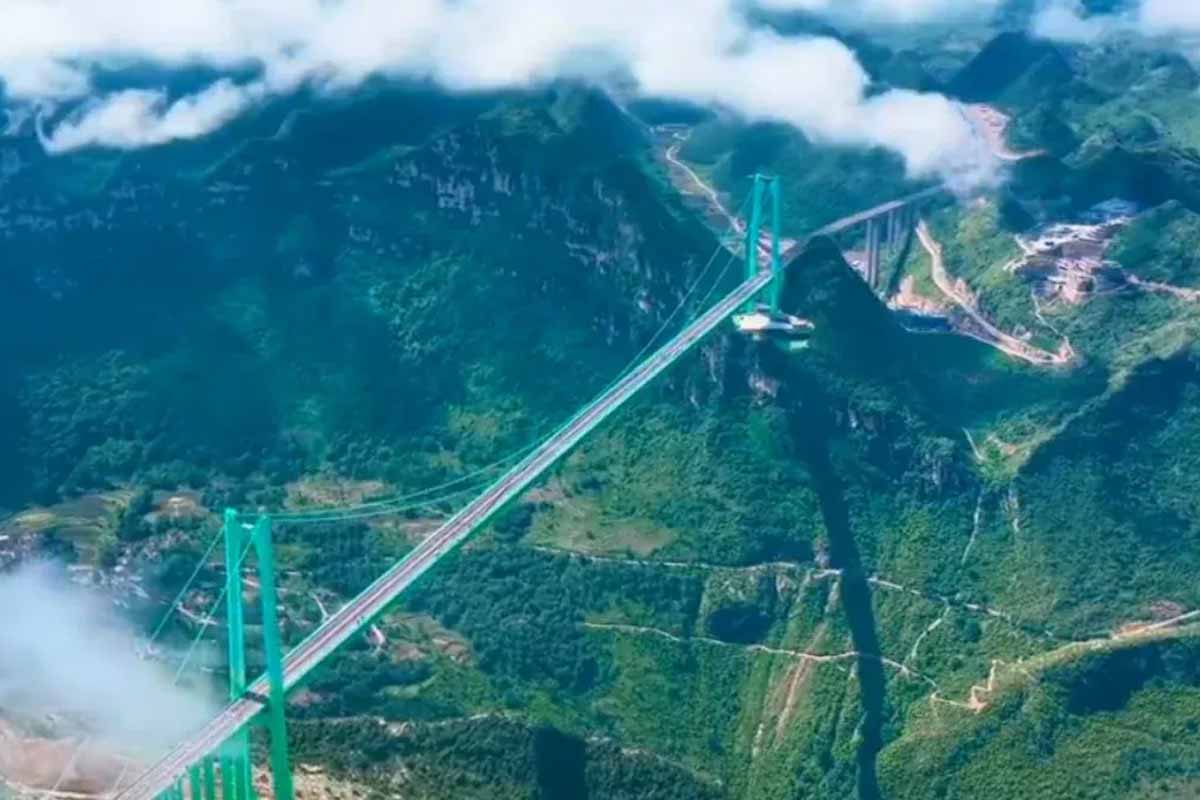A new wonder just touched the sky. Meet the world’s tallest bridge, a ribbon of steel stretched across a staggering Chinese canyon. It’s bold, it’s elegant, and it rewrites what a daily commute can feel like. Stand near the edge and you’ll feel it in your chest—the tug of height, speed, and possibility.
A record that reframes the horizon
On Sunday, Sept. 28, Guizhou welcomed a bridge that seems to float above clouds. It rises roughly 2,050 feet over the Beipan River, a jaw-dropping vertical sweep of air. Locals watched, then drove, then cheered as lanes opened and engines hummed across the deck. The world’s tallest bridge now threads two cliffs into one easy breath of road. Beneath it, the river braids through a gorge that used to divide everyday life. The new span doesn’t just make headlines; it changes habits before breakfast. Traffic glides where detours once wasted daylight and patience. People measure the crossing in minutes now, not moods. Say the name out loud—Huajiang—and you’ll remember how far the road can rise. For many, the Huajiang Canyon Bridge sounds like a promise kept.
From two hours to two minutes
This crossing amputates the drag from a once-painful trip across the canyon. The old route demanded endurance and snacks; the new one asks for a blink. Two hours shrank to two minutes, and the math feels almost mischievous. Tour buses roll sooner. Family visits stretch longer. Business meetings start on time. The world’s tallest bridge now links major tourist spots that once felt annoyingly far apart.
Hotels see earlier check-ins and later sunsets on guest itineraries. Food vendors angle for spots with postcard views and a good breeze. The Huajiang Canyon Bridge folds scattered towns into a single conversation. You can hear it in markets and cafés—more visitors, new accents, livelier nights. Economic lift doesn’t come with a drumroll; it comes with steady footsteps and loaded luggage.
Building high, building fast
Three years and eight months is a blink for a project this daring. Crews poured concrete in tricky temperatures and wrestled with steep, crumbly slopes. Winds tried to boss the work around; engineers argued back with smart rigging and grit. When the dust settled, they finished ahead of schedule and smiled quietly. The deck stretches about 4,600 feet, a long, lean line over open space. It’s part of a total length near 2,900 meters, with a 1,420-meter main span. From canyon floor to deck, you’re looking at about 625 meters of nothing but air. That’s why the world’s tallest bridge doesn’t just top a list—it resets the scale.
In mountainous terrain, no span reaches farther, and that record lands with weight. Say it again—the Huajiang Canyon Bridge didn’t nibble at history; it took a full bite. Engineers whisper about tolerances, cables, and wind shoes like poets trading metaphors. You stand there, and the numbers suddenly feel like weather, not math. Even the name of the older Beipanjiang Bridge now reads like a passing torch. The world’s tallest bridge carries that flame into a new chapter without breaking stride.
More than a crossing: an experience
You don’t just drive this road; you visit it. A coffee shop crowns one tower, roughly 2,600 feet above the river’s shimmer. Take the high-speed elevator up and step into a skybox with real wind. Latte in hand, you’ll watch clouds drift like slow ships under the deck. Bungee jumpers queue with nervous smiles and bravado they’ll edit later. A glass walkway waits at about 1,900 feet, clear as a held breath.
You test the panels, laugh, pretend you’re fine, then look down and laugh again. Phones rise. Knees wobble. Stories write themselves in the notes app. This is where the world’s tallest bridge turns spectators into participants. It’s where everyday life peeks over the edge and grins back. The Huajiang Canyon Bridge becomes a memory machine, stamping dates and heartbeats into travel diaries.
How it stacks up in the world
Context gives a record its echo, and this one echoes loudly. Across the Pacific, Colorado’s Royal Gorge Bridge tops the United States at 956 feet. Built in seven months and opened in 1929, it still pulls crowds and pride. It once wore the world crown until 2001, and the view still hushes conversations. Back in Guizhou, the Beipanjiang Bridge ceded its title with grace and history intact. China now owns the scoreboard, with eight of the top ten soaring spans at home. Each new project lifts the bar and dares the next to clear it.
The world’s tallest bridge is part of a pattern, not just a headline. Travelers will read the numbers, sure, but they’ll remember how their stomachs flipped. They’ll remember the moment the car eased out, wind pressed in, and the gorge fell silent. That’s the power of a road that also behaves like a viewpoint. It’s a shortcut, an arena, a handshake between cliffs. And as the day cools and lights spark along the cables, the idea clicks into place. The road didn’t just get shorter. It got grander. On this ridge of steel and nerve, the world feels a little wider—and closer—all at once.
